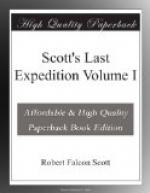Camp 30.—The wind fell in the forenoon, at 12.30 the sky began to clear, by 1 the sun shone, by 2 P.M. we were away, and by 8 P.M. camped here with 13 miles to the good. The land was quite clear throughout the march and the features easily recognised. There are several uncharted glaciers of large dimensions, a confluence of three under Mount Reid. The mountains are rounded in outline, very massive, with small excrescent peaks and undeveloped ‘cwms’ (T. + 18 deg.). The cwms are very fine in the lower foot-hills and the glaciers have carved deep channels between walls at very high angles; one or two peaks on the foot-hills stand bare and almost perpendicular, probably granite; we should know later. Ahead of us is the ice-rounded, boulder-strewn Mount Hope and the gateway to the Glacier. We should reach it easily enough on to-morrow’s march if we can compass 12 miles. The ponies marched splendidly to-day, crossing the deep snow in the undulations without difficulty. They must be in very much better condition than Shackleton’s animals, and indeed there isn’t a doubt they would go many miles yet if food allowed. The dogs are simply splendid, but came in wanting food, so we had to sacrifice poor little Michael, who, like the rest, had lots of fat on him. All the tents are consuming pony flesh and thoroughly enjoying it.
We have only lost 5 or 6 miles on these two wretched days, but the disturbed condition of the weather makes me anxious with regard to the Glacier, where more than anywhere we shall need fine days. One has a horrid feeling that this is a real bad season. However, sufficient for the day is the evil thereof. We are practically through with the first stage of our journey. Looking from the last camp towards the S.S.E., where the farthest land can be seen, it seemed more than probable that a very high latitude could be reached on the Barrier, and if Amundsen journeying that way has a stroke of luck, he may well find his summit journey reduced to 100 miles or so. In any case it is a fascinating direction for next year’s work if only fresh transport arrives. The dips between undulations seem to be about 12 to 15 feet. To-night we get puffs of wind from the gateway, which for the moment looks uninviting.
Four Days’ Delay
Tuesday, December 5.—Camp 30. Noon. We awoke this morning to a raging, howling blizzard. The blows we have had hitherto have lacked the very fine powdery snow—that especial feature of the blizzard. To-day we have it fully developed. After a minute or two in the open one is covered from head to foot. The temperature is high, so that what falls or drives against one sticks. The ponies—head, tails, legs, and all parts not protected by their rugs—are covered with ice; the animals are standing deep in snow, the sledges are almost covered, and huge drifts above the tents. We have had breakfast, rebuilt the walls, and are now again in our bags. One cannot see the next tent, let alone the land. What on earth does such weather mean at this time of year? It is more than our share of ill-fortune, I think, but the luck may turn yet. I doubt if any party could travel in such weather even with the wind, certainly no one could travel against it.




